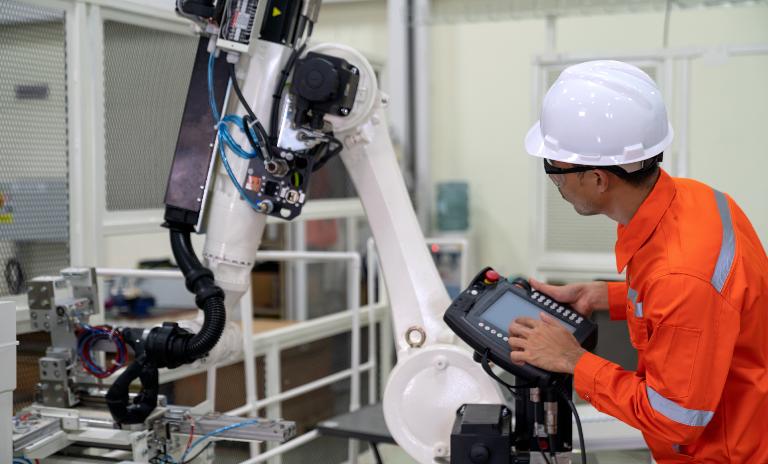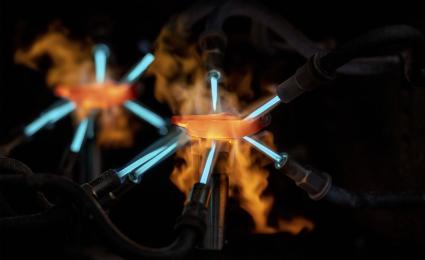Survey by VDMA and Roland Berger: Engineering companies face growing efficiency and cost pressure in their manufacturing operations. Six global trends – sustainability, technology disruption, localization, individualization, populism and digitalization – are ramping up the pressure. Many firms have already exhausted the traditional levers such as automation and relocating production to low-wage countries, etc.


Megatrends spark a paradigm shift in production – Act now to be more competitive
By Oliver Knapp
Next Generation Manufacturing offers a framework within which to reconfigure your production operations
Perfect globalization, perfect supply chains – before the pandemic, many companies implemented lean production, automated manufacturing to the maximum degree, and relocated factories to low-cost countries. They applied the same levers to optimize their business operations, reduce carbon emissions, cut logistics costs, or limit geopolitical risks. However, COVID-19 and the war in Ukraine showed how quickly that setup can be disrupted. In the following Interview, Oliver Knapp, Partner at Roland Berger, points out how businesses are now faced with the task of making fundamental decisions to realign their production operations. If you clearly analyze the megatrends of our time and act decisively, you can make not only your production operations more competitive but also your entire company.

In your latest study , Next Generation Manufacturing, you cite six megatrends that will be decisive for how competitive a company's production operations will be. What are they?
Oliver Knapp: "We've identified six megatrends affecting production that have just passed the tipping point. Finding new solutions that take these trends into account will determine whether or not your own production will remain competitive. The six megatrends are:
First, sustainability. Whether you pay more attention to reducing your carbon emissions or focus more on ways of getting your products into the circular economy , both will have a major impact on your production facilities and processes as well as your footprint. Also important are the share of recycled materials you employ and your choice of energy sources.
Second, we have the matter of industry disruption – market and/or technology driven disruptions (like electrification in the automotive or durable goods sector) not only have a massive impact on a company's positioning but also necessitate drastic changes in production.
Third, individualization. Individualized products, from sneakers to cars, are continually growing in importance.
The fourth is a trend we call location matters. In the past, location didn't usually play a major role – apart from in terms of wage levels. That has changed: The availability of green energy, health & safety, customer preferences, access to certain skillsets in the labor market, human rights records, and so on – the number of criteria that determine the choice of a production location is much greater now. These factors have a direct impact on how you set up a global production network.
Fifth, we have the issue of populism, which is bringing major changes in the production setup. Whether it's America First or China First, the effects on companies – and especially on their production footprint – are huge.
The sixth and final trend is digitalization. This is continuing to have a major impact on business models and ultimately on production – everything from direct customer connectivity to how data is generated and used to cybersecurity requirements."
"Finding new solutions that take ongoing mega trends into account will determine the competitiveness of your own production."
Do companies view these serious changes as more of a risk or an opportunity?
Oliver Knapp: "It's possible to see it all as a challenge, but we at Roland Berger view production realignment as a definite opportunity. An opportunity to break from doing what everyone else was doing before, which in production was almost exclusively focused on cost reduction. Western companies in particular, which have suffered the most from cost pressures up to now, should take these megatrends and turn them to their advantage. In other words, help their production evolve from a time-consuming and cost-absorbing factor into a competitive advantage!"
In the context of your study, what is the role of Germany's law on corporate due diligence obligations for the prevention of human rights violations in supply chains?
Oliver Knapp: "This is something that has to be considered from a wider perspective. A big trend that will affect manufacturing going forward is the need to consider sustainability as a strategic factor. This includes the classic environmental, social and governance (ESG) standards. Business decisions are now being made on the basis of ESG data and parts of the supply chain law you mention have a role to play in this. Compliance with ESG principles is not just demanded by lawmakers and customers, it is also required by the capital market. Because if you can show better environmental ratings, you'll be offered better financing terms – which in turn makes you more competitive."
In the same study, 51 percent of the companies surveyed said they are keen to establish an asset light business model. What is your view on that?
Oliver Knapp: "Primarily, most companies want to reduce their assets in order to optimize their financial situation. The second point is the risk aspect: The more assets you own, the higher the break-even point. In our VUCA world – a world that is volatile, uncertain, complex and ambiguous – the break-even point is higher for many companies, which is why they are now trying to flex their costs and therefore reduce their assets. The trend towards de-coupling is also influencing the movement in this direction. But at the end of the day, how competitive your production is will be decided not by your value chain coverage alone but by whether or not you as a company have found ways to respond to the six trends."
What processes would companies be best advised to set in motion now?
Oliver Knapp: "The war in Ukraine has complicated everything and added another layer of things to think about. First of all, you have to consider the impact on your products in terms of their sales markets, production locations and purchasing footprint. Particularly when it comes to your production footprint – depending on your risk assessment – you'll have some fundamental decisions to make, not only about any locations in Ukraine but ones in other countries, too.
Going back to Next Generation Manufacturing in the narrower sense, the first thing to do is to examine which of the trends impact your own company and ultimately your own production operations in a major way. And then the main question to ask is: To what extent are we already turning these trends to our advantage?"
How is the situation now different to the pandemic scenario of the last two years?
Oliver Knapp: "At the beginning of the pandemic, what was important was to establish an adaptive setup featuring resilience, flexibility and elasticity. Many companies had already developed specific contingency plans after the 2008 financial crisis, which they were able to pull out of the drawer in 2020. Those that had taken agility and risk management seriously were clearly at an advantage these last two years.
But given the current geopolitical and economic situation, companies now find themselves at a crossroads: Is our economic system going to revert back to the perfectly globalized world where everyone works together on the basis of economic interest? Probably not. But what might the future look like? It makes a very big difference whether you believe in one possible constellation or the other, because behind that lie fundamental decisions and business strategies that you won't be able to change so fast. If the situation remains as it is and companies rebuild their production network region for region, that goes hand in hand with high investments and it means your cost level for the coming years is set. So, are you perhaps going to stop doing what everyone else is doing? That said, it's not only the way you react in relation to how your competitors react but also the timing that is crucial. Being too slow can quickly become an existential threat to your business, but being too fast can also lead to competitive or financial problems. The upcoming decisions represent a fork in the road. Every company should work through these decisions now. Next Generation Manufacturing offers a framework within which to reconfigure your production operations.





